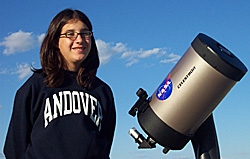|  |  | |  |

|  |  |  |  |  | With One Eye on the Sky
|
08.05.04
|
Who are NASA's Earth Explorers?
The elementary school student questioning if El Niño occurs anywhere besides the Pacific Ocean. The researcher investigating connections between Arctic ozone depletion and global climate change. The citizen scientist interested in how changing land cover and use affects animal migration patterns. And the businessperson projecting future needs for harvest, delivery and storage of crops. All of these people are Earth Explorers -- they are all connected by their curiosity about Earth system processes. This monthly series will introduce you to NASA Earth Explorers, young and old, with a variety of backgrounds and interests.
Nominate an Earth Explorer!
Do you know someone who would be a good subject for this series? We're
looking for students, teachers, scientists and others who are working
with NASA Earth science data and imagery to better understand our home
planet. Send your nominations to Dan Stillman:
dan_stillman@strategies.org.
|

|
Abigail's journey to becoming a NASA Earth Explorer began with a passion for scientific inquiry. Whether observing the beautiful skies above while on a family trip to Yellowstone National Park, stargazing with her 8-inch Schmidt-Cassegrain telescope, or attending science lectures at Princeton University, Abigail, 14, can't remember a time when she hasn't been exploring and studying the world around her.
Image to right: Abigail is this month's NASA Earth Explorer. Credit: NASA
Growing up in New Jersey, Abigail quickly became interested in Earth science with the help of her father, an amateur astronomer and the manager of an engineering company. As early as 5 years old, she recalls the joy she felt in learning science facts from a game her father gave her.
It's no surprise then that two years ago, as a seventh-grader in New Jersey, Abigail was excited to learn that her school was involved in NASA's S'COOL (Students' Cloud Observations On-line) program. It was S'COOL director Lin Chambers that gave a presentation at the school and first introduced Abigail to the program.
"I loved astronomy and all things NASA-related," Abigail said. "[The S'COOL program] was an opportunity to help NASA."
S'COOL is an education and outreach project in which K-12 students make observations of clouds and other weather variables from the ground for comparison with measurements taken from space by NASA's CERES (Clouds and the Earth's Radiant Energy System) satellite instrument. CERES measurements contribute to our understanding of the interaction between clouds and solar energy, a significant factor controlling our climate.
Abigail enthusiastically embraced the program, observing clouds, studying Earth science, even writing reports for her science classes.
In one report, she studied seasonal trends of temperature, relative humidity and the occurrence of contrails, and found the values of all three to be lower in the winter than in warmer months. Abigail hypothesized that "because the Sun is the natural cause of all weather, and since its rays shine more directly on the Earth (northern hemisphere) in fall and spring, contrails form more readily in summer, spring and early fall than in winter and late fall."
Abigail's work illustrates the mission of S'COOL: to enable collaboration among students and researchers and advance student interest in scientific inquiry.
"Scientists benefit from the use of student observations to help validate the CERES measurements; students benefit from their participation in a real-world science experiment," said Chambers, a research scientist at NASA's Langley Research Center.
Working with NASA has inspired Abigail to explore other opportunities for advanced study. This year she will participate for the third time in the Johns Hopkins Center for Talented Youth summer program, where she will take classes in a collegiate atmosphere. The courses encourage "close reading, clear and graceful writing, careful collection and analysis of data, and critical thinking," each of which is a component of scientific inquiry.
Abigail has also been accepted into this fall's class at a prestigious school in Massachusetts. This school offers advanced courses in biology, chemistry, physics, cosmology, mechanics, meteorology and environmental biology, and has high-tech equipment including a recently refurbished telescope and a newly constructed observatory.
In a speech to the incoming class, the school's dean of admissions commended Abigail for helping her school to make S'COOL's monthly list of the 10 schools reporting the most observations. For the year starting August 2002 and ending July 2003, the school finished 15th overall.
"I would have probably never been accepted to the school had it not been for S'COOL," Abigail said.
What might the future hold for this Earth Explorer? The answer may be found in the clouds, or even in the stars. Abigail, just a freshman in high school, already aspires to attend a "science-oriented college," such as MIT or Caltech. She has even considered following in the footsteps of her great-grandfather, who went to an engineering college and founded the engineering company Abigail's father now manages.
In the meantime, Abigail says she will continue to foster her passion for science by exploring and studying the world around her. She hopes to participate in SHARP, NASA's Summer High School Apprenticeship Research Program, before graduating.
See previous Earth Explorers articles:
+ View site
Related Resources
S'COOL
+ View site
NASA SHARP
+ View site
Katherine Lorentz, NASA Langley Research Center
|
|  |
|
